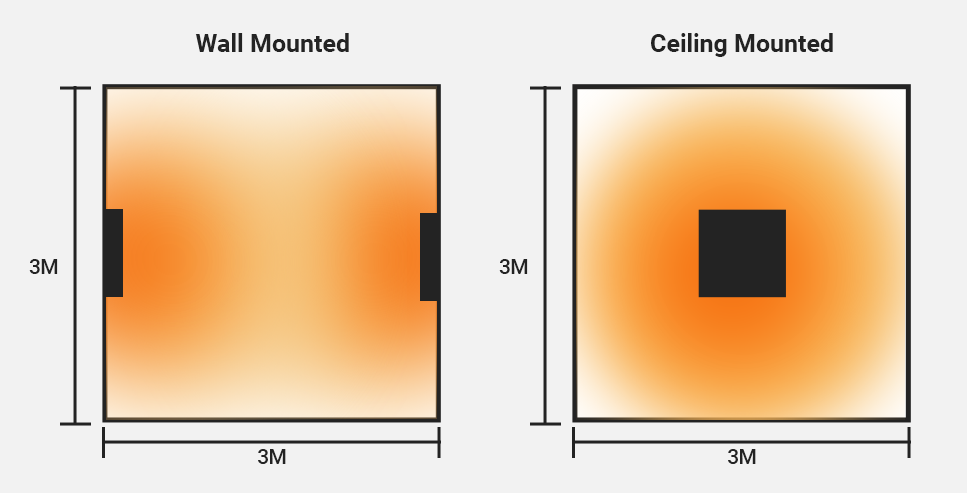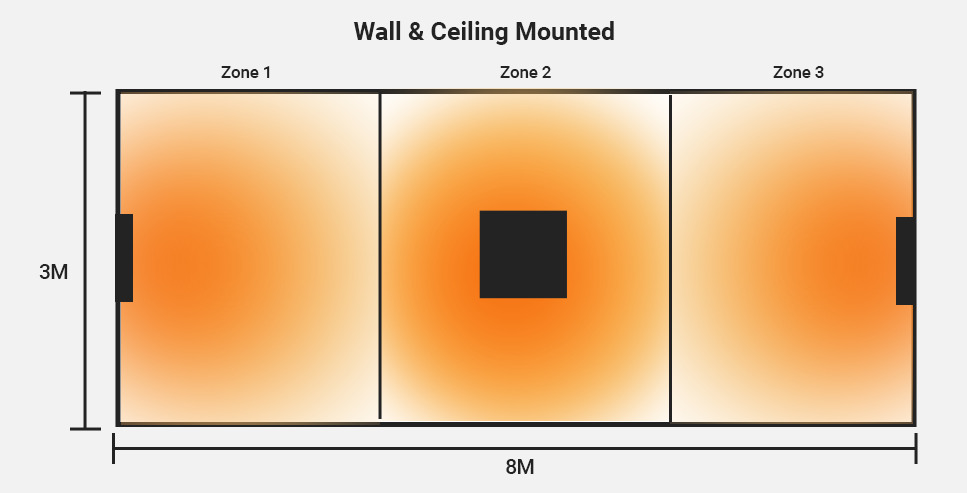When making the switch to infrared, it’s important to remember the quirks of IR, more specifically, how it differs from conventional radiators.
The primary difference being that infrared is directional - it heats what it sees.
Convection radiators on the other hand can make areas warm even if they’re not in direct line of sight of the radiator itself.
This is something that is at the centre of understanding how to maximise infrared heating in your home.
The Boundaries of Infrared
Like any other heat source, infrared has a range - inside that range you’ll feel plenty of heat, and outside that range you won’t feel much.
Think about it like this: if you put your hand over a hot cup of tea, your hand feels warm, but move it further away, and you won’t feel it.
Naturally, the greater the heat source, the further the reach is. This is why you’ll only feel the warmth from a cup of tea from a few centimetres, but the sun keeps us very warm despite it being 93 million miles away - the sun is very obviously a greater source of heat than a cup of tea.
This sounds obvious, but it’s key to understanding how best to utilise infrared in your home.
The ‘range’ of an infrared panel is approximately 3m, and the optimal warmth can be felt within the first 2m.
We can essentially double these for any heaters using near infrared, like our Athena and Theia IR Bar Heaters, with their reach being 6m and the optimal zone being 4m.
Applying The Boundaries of IR To Your Home
When deciding how many heaters you need for your rooms then, a good place to start is by splitting your room up into approximate ‘zones’ of around 3m x 3m. You can then pick one or two heaters to heat that zone.
The number of heaters you need depends on where you install them.
Wall mounting them will probably require you to install two heaters per 3m x 3m zone, as the heat from one panel won’t adequately cover the other side of the zone.
This is why ceiling mounting your panels is a great option, as you’d only need one panel in any given 3m x 3m zone.
A good question to ask at this point is: if the mid to high power panels can generally cover the same areas, then what’s the point of the larger panels?
Warm Up Time
The main difference between say, a 700W IR Panel and a 1200W IR Panel, is the length of time it takes to warm the area up.
The trade off here is power consumed vs time spent switched on, and which side you decide to favour can come down to personal preference. If you want to feel warm now, then a larger panel is best for you.
The area you’re heating also plays a part too.
For example, a space like the living room is in use fairly frequently, and as such you’d want a more constant stream of heat here. With this in mind, you can probably go for a lower energy consumption with a longer warm up time, knowing that the area will have residual heat.
All you need to do is simply maintain that warmth, which means you don’t need that sudden burst of heat to quickly bring it up to temperature, as it’s most likely not far off anyway.
Now think about a room like the bathroom or garage for example, that aren’t used anywhere near as much as a living room. These won’t have much residual heat at all, and most likely will need a blast of heat to bring it up to temperature.
For this reason, you’d want a high power heater for these spaces, capable of moving the needle in as short a time as possible.
How This Works In Practice
Let’s say we have a 3m x 3m room. We have two main options with how we heat it. Option one is to use two infrared panels on opposite walls so that we even out the spread of heat as much as possible.
The second option is to ceiling mount a single panel, which would give us a better spread than option one, as the panel can ‘see’ more of the room.

Let’s take things up a notch - now we’ve got an 8m x 3m room, so substantially larger than the previous example.
We can generally split this up into three smaller zones of approximately 3m x 2.6m.
What we would recommend for a room like this is one wall mounted heater at either end of the room. Then, a single ceiling mounted panel in the centre of the room to cover the central zone.

Need More Assistance? Get In Touch With Our Team
It goes without saying that this is a completely different concept to think about in terms of how you heat your home.
And it can be a lot to wrap your head around!
If you do need any further assistance with understanding how best to heat your space, or you have an exceptionally quirky space, then all you need to do is get in touch with our team on 0116 321 4124, or send an email to sales@suryaheating.co.uk.
Don’t forget that you can also speak to us on Facebook and Instagram too, and be sure to check out our YouTube channel for all things infrared heating.





